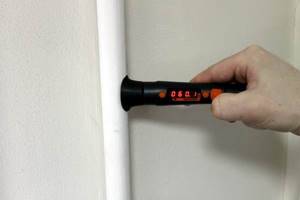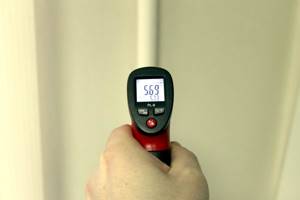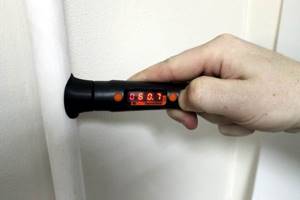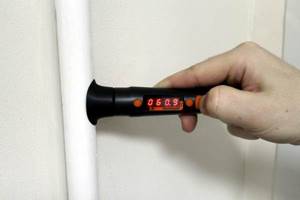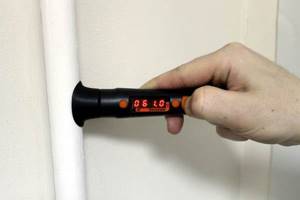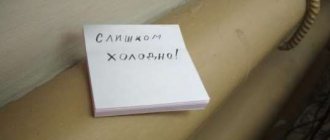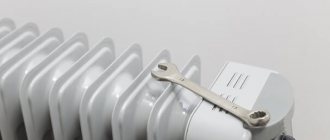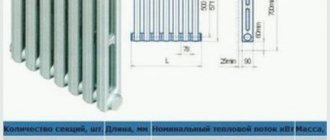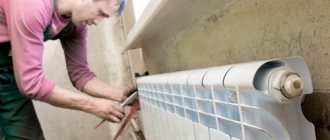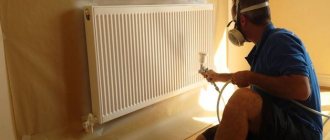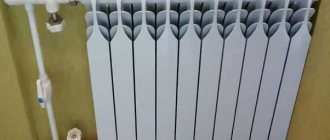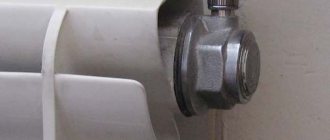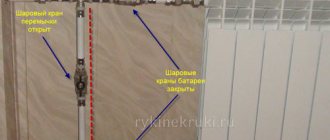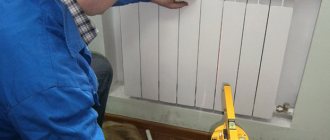A thermometer is a device that is necessary for measuring temperature.
With its help you can set, regulate, and measure the temperature. A modern boiler room needs such a device, because lack of control can cause a breakdown. Boiler house owners are forced to install devices on equipment intended for heating. There are heat generators that already have a sensor installed in the pipe.
Thus, gas devices are equipped with products that communicate directly with the control unit. This allows readings to be taken in real time.
For a solid heating boiler, devices are used that are capable of displaying the current temperature. But if there is no built-in device for the systems, then you need to think about how to measure the temperature.
Parameters for starting heating
As autumn approaches, the temperature outside becomes lower and lower, people touch their batteries every day and hope that today they will become hot. If this does not happen, then the residents look for the culprits, but in fact, all standards for the supply of heat to houses are specified in Resolution No. 354 of 2011.
This document states that heat is supplied at an outside temperature of 8 degrees Celsius, if it lasts for five days in a row . If this indicator fluctuates in one direction or the other over the specified time, then the radiators and risers in the apartments will remain cold.
Heat is supplied only on the sixth day and, as a rule, in most cases the heating season begins on October 15 and ends on April 15.
In this video you will learn the temperature standards in the apartment:
Adjusting heating at home
If, after you have measured the heating of radiators at home with your own hands, the heating of the pipes exceeds the norm, then it should be adjusted. This can be done using special devices by hanging curtains with increased density on the windows.
But what to do if the heat is not enough? In this case, you should call the utility workers. Specialists must take measurements of data in the water supply and heating systems. Then they must draw up a final act. If non-compliance with the standard is confirmed, utility employees will resolve the problem.
If this option of calling utility services seems absurd or impossible to you, then the solution will be to insulate your home, and possibly replace the batteries with new heating devices.
Standards for an apartment
Temperature standards in heating radiators are different for a particular room. The air in apartments should be heated to the following level:
- living area and kitchen - +18°C;
- corner apartments - +20°C;
- bathroom and toilet - +25°C.
Corner apartments should be heated more strongly due to the presence of cold corner walls. The standards for common premises are slightly different:
- entrance — +16°C;
- elevator — +5°C;
- attic and basements - +4°C.
Measurements in a residential area are made on the internal walls no closer than a meter from the outer wall and one and a half meters from the floor level.
If the parameters do not comply with the standards, the consumer must notify the management company. After the required checks, the heat charge can be reduced by 0.15% per hour of deviation from the standards.
How does heating work in apartment buildings?
The heat that goes into our homes is generated at thermal power plants or boiler houses. There the water is heated to be piped into the houses.
It must reach the batteries hot, so it must be very hot. Every schoolchild knows that at 100°C water will boil, but this does not happen with water in heating pipes. A pressure of 7-8 atmospheres is created in heating pipes, which increases the boiling point of water to 160-170°C. There are different coolant distribution schemes (this is how official documents call water in pipes and radiators) coming from a thermal power plant.
In the most common, so-called independent heating supply scheme, water does not go directly to the apartments.
First, it is sent to a heating point located in the basement of a high-rise building, where it passes through a heat exchanger and cools to a temperature acceptable for supply to the rooms. The water in the radiators should not be too hot - this is simply dangerous. Having passed through the heating radiators inside the house, the coolant, which has already cooled by 25-35 ° C, returns to the same heating point - to heat up again and enter our homes.
Battery temperature
There are minimum and maximum standards. Sometimes, even when heating is started, there is not enough heat in the room due to the fact that the temperature of the radiators is far from the standards. The reason for this is the banal airiness of the system. You can fix the problems with the help of a specialist or yourself using a Mayevsky crane.
If the problem arises due to worn-out riser pipes or batteries, then you simply cannot do without the help of specialists. If the heating system did not work and the air in the apartment was colder than specified in GOST standards, then this entire period is not subject to payment.
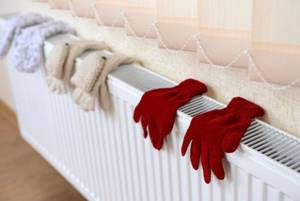
There are no minimum temperature standards for heating radiators, so it is customary to rely on the air parameters in the apartment. Normal air parameters during the heating period are +16…+25°C.
To document that the temperature of the heating system does not meet the norm, it is necessary to invite an authorized representative of the heating service provider. What the water temperature in the batteries should be is described in SNiP 41−01 of 2003:
- If a two-pipe design is used in the room, then 95°C is the maximum.
- The norm for a single-pipe design is +115°C.
- The winter temperature norm for heating radiators in an apartment is +80…+90°C. If it approaches +100°C, then urgent measures must be taken to prevent water from boiling in the system.
Although many battery manufacturers often specify a maximum temperature threshold that is high, you should not reach it frequently as this will damage the battery.
To ensure that the heating complies with GOST standards, you need to take your own measurements and understand what the temperature of the water in the heating radiators is:
- An ordinary mercury thermometer can be used, but then 2°C will need to be added to the result obtained.
- An infrared thermometer will also work.
- The alcohol thermometer must be tightly tied to the battery, wrapped in thermal insulation.
If the results obtained are far from normal, then you need to submit an application to the heating network office with a request to carry out control measurements . A commission will visit the apartment and make all the necessary calculations.
Air temperature standards in the apartment
The feeling of comfort from heating a room is subjective. However, there are uniform standards determined by the physiological needs of a person, as well as the purpose of the premises in which he resides.
Although there is a fairly wide range of standards that prescribe what the temperature of the water in the heating system of an apartment building should be, the standards for the thermal conditions of the air in the apartment are very unambiguous.
So, in accordance with the standards, during the heating season the following temperature regime must be maintained in the apartment:
- in the living room - 18 °C;
- in a living corner room - 20 °C;
- in the bathroom - 25 ° C;
- in the toilet (separated from the bathroom) - 18 ° C;
- in a shared bathroom - 25 °C;
- in the kitchen - 18 °C.
This standard according to GOST allows you to preserve the health of residents without exposing them to adverse conditions.
How to choose the right thermometer for a boiler?
There are two types of thermometers: immersion and remote .
If you are faced with the task of choosing thermometers for boilers, then you need to be extremely careful. You need to understand that such devices have a fairly simple and reliable design. It must be suitable for hot water and made from quality materials.
Many modern boilers for heating systems are already equipped with appliances . But for old-style boilers, you need to purchase such a product and install it in the appropriate place.
It is worth considering the main functions that the device performs. It is intended for:
- Displays readings of the operating temperature of the coolant . Thus, the water carrier can monitor and determine its temperature. This ensures stable operation of the entire system, including the boiler. The boiler owner who installs measuring instruments gets the opportunity to set the desired temperature and change it if necessary. It is the thermometer that can indicate problems that have arisen. If the temperature of the liquid has noticeably decreased, then it can be understood that there is a problem in the system. Such a pointer will allow you to disable the system until the problem is resolved.
- Remote control . This control method is the most convenient; it allows you to set the temperature, change it without being near the equipment. Many boilers operate automatically; measurement is carried out using special sensors. Sensors and automation interact harmoniously with each other. Due to this, you will not need to constantly be at the boiler , monitor indicators, and regulate the temperature.
Industrial
Large (and not only large) industry also uses water in tens of thousands of technological processes.
Careful control of fluid temperature ensures that these processes are carried out in the most optimal way.
Models equipped with special sleeves are characterized by increased stability and can last much longer even in a rather aggressive environment.
Bimetallic thermometers of various categories are often used in heating systems. At industrial facilities you can also find pressure gauge devices that operate remotely.
The physical basis for the operation of a manometric thermometer is a clear relationship between pressure in a closed volume and temperature. Some devices may have a unit that converts measurement results into electrical impulses. The remaining components (a balloon connected through a capillary to a special meter) remain unchanged in any case.
The remaining components (a balloon connected through a capillary to a special meter) remain unchanged in any case. This technique is used even in explosive industries. However, the measurement accuracy is relatively low, and the thermometer itself takes up quite a lot of space.
OFFICIAL Rules for measuring water temperature in the domestic hot water system (hereinafter referred to as Tgvs) are as follows:
The time for draining hot water before measuring its temperature is set:
- paragraph 5 (note) of Annex 1 “Rules for the provision of utility services to owners and users of premises in apartment buildings and residential buildings” (approved by the Decree of the Government of the Russian Federation No. 354 of May 6, 2011): “... BEFORE DETERMINING THE TEMPERATURE OF HOT WATER AT THE POINT OF WATER DISCHARGE THE WATER WILL BE DRAINED FOR NO MORE THAN 3 MINUTES.”
- clause 7.5 of the Methodological Instructions MUK 4.3.2900-11 “Measurement of the temperature of hot water in centralized hot water supply systems” (approved by the Federal Service Rospotrebnadzor on July 12, 2011) it is established that when draining hot water before measuring its temperature “... The water consumption should be AT LEAST 2 LITERS PER MINUTE (determined by the time it takes to fill the measuring container).”
We recommend reading: Do you need a permit to remove a curtain wall?
According to the arithmetic textbook for 1st grade: 3 min.
x 2 l/min. ≥ 6 liters! Regulatory documents, unfortunately, do not contain other rules establishing any specific volume of water that must be drained from the water collection point before measuring Tgvs. You understand perfectly well that the more water is drained before measurement, the greater the likelihood that not the temperature of the water in the tap will be measured, but the temperature of the water in the supply line along the water path from the boiler room (from the thermal power plant) to your tap! Personally, I believe that in order to measure Tgvs, it is NECESSARY AND SUFFICIENT to drain a volume of water equal to its volume in the pipe in the apartment from the hot water riser to the tap.
For a hot water pipe with a diameter of 3/4 inches (2.54 x 3/4) = 1.9 cm in length from the riser to the tap L ≈ 3 meters volume V = π *D2/ 4* L = 3.14 * 1, 92/4 * 300 = 716 cm3 ≈ 1 liter.
If the hot water circulation system is working properly, the time during which the cooled water will drain from the pipe in the apartment from the riser to the water tap with a volume of ~1 liter* is no more than 10 - 30 seconds.
But also the drained volume is 3 minutes. x 2 l/min.
= 6 liters (but no more!), calculated by us above on the basis of clause 5 of Appendix 1 “Rules for the provision of utility services...” (approved by the Russian Federation Government Resolution No. 354 of May 6, 2011) and clause.
7.5 Guidelines MUK 4.3.2900-11
“Measuring the temperature of hot water in centralized hot water supply systems”
(approved
Fed. by the Rospotrebnadzor service on July 12, 2011) is quite sufficient for a reliable measurement of Tgvs. Practice in advance before the commission arrives to measure Tgvs, what kind of stream should flow from the tap so that in 3 minutes a stream of 2 - 3 liters per minute (no more!) fills the “measuring container”, i.e. simply put - a saucepan, a basin with a volume of 3 minutes.
x 2-3 liters ≈ 6-9 liters! This is a very small stream. You can measure the hot water consumption using the meter.
When measuring, time the water draining yourself - you probably have a stopwatch in your mobile phone.
Do not let the meter open the tap at full power so that the splashes fly all the way to the ceiling and you end up measuring not the temperature of the water in your tap, but the temperature of the water in the supply line at the entrance to the house, or in the boiler room (at a thermal power plant).
During one of the measurements, the meter and I grabbed the tap alternately - I decreased the water flow, she increased it.
As a result, I wanted to write down in the act the actual water consumption measured by the meter and the “measuring container,” but the meter snatched the act from my hands and the commission took it away without my signature. But when at the trial the housing and communal services lawyer tried to attach this act to the case, the judge, in response to my statement, that “... the act without my signature in accordance with paragraph.
But when at the trial the housing and communal services lawyer tried to attach this act to the case, the judge, based on my statement that “... an act without my signature in accordance with paragraph 109 of Rules No. 354 cannot have legal force,” refused this lawyer. So you, too, be careful before signing the act... Well, how much water will be drained by the HOA meter when measuring the HHVS in your apartment will depend both on your “impudence” and energy, and on the impudence and energy of the HOA meter.
But it is advisable to reach an amicable, business-like agreement with the HOA meter about how much water will be drained before starting to measure the temperature. Be prepared for the meters to show their knowledge and stick the text under your nose: “...Before taking hot water samples, you should drain the water until a constant temperature is established. The time for draining the water can be up to 10 minutes…”, set out in the same paragraph 7.5 of the Methodological Instructions MUK 4.3.2900-11.
Tell them in response that the Government Decree has greater legal force than MUK 4.3.2900-11 of Rospotrebnadzor, especially since Government Decree No. 354 was issued later. Good luck with measuring the water temperature!
What types of thermometers are there?
Heating allows the use of a variety of pipe devices. Many people have to think about which thermometer to measure temperature with. But the installation of a thermometer on a pipeline depends precisely on the characteristics of the system being used or designed. It is worth considering the types of sensors.
ATTENTION! Some sensors are designed for temperatures up to 100 degrees, but the standard temperature in a heating system is 40-50 degrees.
Liquid glass thermometers
Such a measuring device is a device that must be mounted at the location where the measurement will be taken. The device is installed in the system, and mercury .
Some manufacturers suggest using a device that is filled with methylbenzene, kerosene or alcohol. When choosing a substance, you need to take into account the environment in which the thermometer is located.
So, one device is selected for water heating, and another for capillary gas heating. This product is considered the simplest.
Manometric thermometers
This option has a more complex design when compared with a glass device. If we consider the main elements that a pressure gauge has, we need to mention:
- cylinder , which is located at the control point where the temperature is measured;
- capillary , which is somewhat reminiscent of a connecting tube;
- pressure gauge , which has a spring design.
If we consider the features, it is worth saying that there is gas under pressure inside the cylinder. Due to pressure fluctuations, measurements are carried out.
Electric resistance thermometer
For heating systems, you can select an electric resistance thermometer. It works according to the principle of changing the electrical resistance of different types of metals.
Changes occur under the influence of high temperatures. It is worth noting that the most sensitive component of the product is the wire spiral . In this case, the sensor responsible for measuring temperature is reliably protected by a special shell.
Submersible devices
Water products allow you to measure the temperature from inside the pipes. It is necessary to choose a device for the water supply system, taking into account modifications of the system and a suitable method for recording readings.
Bimetallic
The devices work by deforming the material when heated. This causes pressure on the indicator needle. The devices are good because the accuracy of their readings is very high .
Alcohol
You can consider not only water, but also alcohol devices; they are somewhat similar to ordinary devices. The indicator is alcohol , which is hidden in a sealed flask.
If heating occurs, the liquid expands, the arrow points to the corresponding division. It is worth noting that such devices have a significant drawback - it is inconvenient to take readings from them.
Methods for measuring water in radiators
Many people wonder how to measure the coolant parameter in an apartment? There are several ways:
- Use a regular thermometer (on the surface).
- Using an IR thermometer.
- Use an alcohol thermometer.
- Using an electrothermometer.
If you measure the coolant in an apartment with a regular thermometer, then you should add another 1-2 degrees to the final figure. The use of devices with infrared radiation provides more accurate data. The readings of an infrared thermometer (pyrometer) may differ from the actual ones by only half a degree.
To constantly measure the temperature of a heating radiator, you can use an alcohol meter. Attach it to the battery, for example, with adhesive tape and wrap it with material with thermal insulation properties (foam rubber, flywheel).
You can also use an electric thermometer for such measurements. Just tie the wire to the radiator. It will show heating indicators.
Important! If you decide to call a commission to measure the temperature of the battery, then the measuring apparatus used by specialists must be certified. All actions of workers must comply with GOST 30494, paragraph 4, section “Control methods” [3].
Features of choice
To choose a heating device, you need to study the definitions of different types and choose a suitable thermometer. The meters have the appropriate characteristics; you should pay attention to the following features:
- Connection method . If the task is to determine the temperature as accurately as possible, then experts advise making a choice in favor of submersible devices.
- It is necessary to consider whether the repair of devices is difficult.
- Working range . This indicator also affects accuracy. If the device is selected incorrectly, it may display the temperature incorrectly or stop working.
- Method of taking readings . The inertia of the device must be taken into account, that is, the speed of bringing the readings to the real level.
Thermometers for measuring water temperature in heating systems
» Heating » For the normal functioning of heating devices and equipment, in particular, boilers, steam generators, economizers, constant monitoring of inlet and outlet temperatures is required using a variety of special measuring instruments. Temperature measuring devices are conventionally divided into two large groups.
The first includes devices that measure temperature using a contact method, the second includes non-contact measuring devices.
Measuring instruments are also divided according to the principle of their operation. There is the following gradation of thermometers:
- expansion thermometers, including liquid, manometric and dilatometric;
- thermoelectric thermometers;
- resistance thermometers.
What should you pay attention to?
Before purchasing a pipeline device, it is worth clarifying a few points:
- The insertion must take place exactly in the place where the device is intended to be installed. That is why you need to first find a suitable place near the steam boiler and find out the method of fastening .
- You need to figure out what the appropriate temperature range . Experts advise choosing the appropriate product; its upper limit should not be too high. The larger the division scale, the greater the error may be. This error may reduce the reliability of the product.
- You need to find out in advance whether a pressure gauge . If it is not provided for in the system initially, then it can always be purchased in addition.
How to measure the temperature of the coolant in the heating circuit?
Water can act as a coolant in a heating system.
, and
antifreeze
. It all depends on the climate of the area.
When the power goes out, the boiler stops heating the coolant. In the northern part of Russia, especially in winter, frozen water can lead to rupture of pipes, so the use of corrosion-resistant low-freezing liquids is relevant here.
When organizing a high-quality heating system, it is important to use special antifreeze for heating circuits. Contains ethylene glycol
.
Not long ago, Russian manufacturers began producing environmentally friendly antifreezes containing food-grade propylene glycol
. Antifreezes are available in two modifications depending on the lower operating temperature: up to -65 °C and up to -30 °C.
Neither ethyl alcohol nor transformer oil are suitable as a coolant, because when heating buildings it is important to take into account fire safety and the conditions for using antifreeze in residential buildings.
It is necessary to select the type of coolant before designing the system. This is due to the following reasons:
So, if you don’t plan to live in the house in winter, there is a danger of turning off/extinguishing the boiler, or you yourself turn off the heating when leaving to save money, you should choose antifreeze. In all other cases, it is easier and cheaper to use water as a coolant.
For optimal control of the temperature of the coolant and the boiler, thermostats are used, which allow you to effectively control the “return” and “supply” temperatures. To monitor coolant temperatures, resistance thermometer
(RDT)
, which operate in the low temperature range. Let's look at the modifications that are used to control coolant temperatures:
They have different designs: sensors without fasteners, sensors with fasteners or with a fitting, which can be welded, movable, or spring-loaded.
There is a version with a plastic head, as in the picture, and also with a metal head.
035 and 045 are very popular for measuring coolant temperatures
and also with a fixed fitting -
065
model of this series.
Source
Checking the device
It is not enough to choose a suitable measuring device; you also need to check it after purchase. Experts say that it is best to check the accuracy of the readings .
This is necessary to ensure that the products provide accurate data. If you select a cheap device, then you can suspect that its readings will be inaccurate. You should not save on purchasing products, because a low-quality device can lead to a distortion of the real picture, a decrease in the efficiency and reliability of the system.
It is quite easy to carry out the test; for this you will need to take a device and a sensor with a remote spike for water. It is necessary to check the product near an open fire source . It will be enough to bring the thermometer to the fire for 10 seconds, and then do the same with the sensor.
Taking into account inertia, it is necessary to evaluate the readings that will appear on the instruments. You need to compare the readings on the sensor and the thermometer. The lower the difference, the more accurate the device will be.
Bad results: what to do
If the indicators are too low, you need to:
- File a complaint with the above organizations.
- Check whether the device that the commission brings with it has passed registration and state inspection. It must also have a quality certificate.
- Check the correctness of the commission's actions. To do this, you should read the document “Control Methods” GOST 30494-96.
- If the heating system is working correctly, you need to check the radiator. If the reason is a weak water flow, that is, improper operation of the heating network, then look for the same residents of the house, form a collective complaint and go to court.
If the battery heats up more than necessary, then you can use a thermostat with a temperature sensor.
It must be installed on the inlet fitting and then the water heat flow must be adjusted. The adjustment can be manual or automatic. In the first case, the temperature sensor does not need to be used. Only the valve is used.
It is better to use an automatic thermostat. It has its own sensor, which determines when it is necessary to adjust the operation of the heating battery.
Useful video
This video is a brief overview of two thermometers from the German company Watts.
In order to live comfortably in an apartment or country house during the winter, it is necessary to equip a heating system. If you live in the private sector, this may be an autonomous network, but if you live in an apartment building, then it is centralized. In any case, it is necessary that the temperature of the batteries during the heating season complies with the standards provided for by law and the relevant SNiP.
Temperature standards for the heating system in an apartment building
The heating circuit in apartment buildings is built in cooperation with a centralized system to which the pipes are connected. Through them, the coolant is directed to the apartment building, where its further supply is regulated by inlet valves. After this, the water goes through the risers and eventually ends up in the radiators and radiators of each apartment.
The described processes, as well as everything related to the rules for providing the population with communal resources, are reflected in (hereinafter referred to as Resolution No. 354). Heating quality requirements are set out in Section VI of Appendix No. 1 to the rules of Decree No. 354.
In addition, detailed rules for the provision of heating services are prescribed in 06/11/14 No. 544-st “GOST R 51617-2014. National standard of the Russian Federation. Housing and communal services and management of apartment buildings. Public utilities. General requirements" (hereinafter - GOST R 51617-2014) and (hereinafter - GOST 30494-2011).
These acts establish the parameters of the coolant for the heating system of an apartment building. Thus, the temperature of the coolant (water) when supplied to the system is equal to the temperature of the water when it leaves the heating boiler. As a rule, the coolant should be brought to a temperature of 130-150 °C, but this indicator also depends on the outside temperature in the region.
Typically, the water leaving the boiler should have a temperature of 115 °C.
However, the standard temperature in the heating system can be within 95 °C or 105 °C (for different systems).
Next, to create comfortable conditions in the room, the proper condition of the parameters of the riser, which conducts water from the heating unit to the apartment, is ensured. They vary depending on the summer and winter seasons.
Of course, in practice, the temperature of the coolant in the riser depends on the operation of the thermal power plant and on heat loss on the way to the house. However, the riser temperature in winter should be in the range of 70-90 °C.
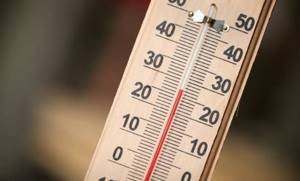
When does the housing office carry out work on connecting batteries?
In Russia, the heating season begins when the average daily outside air temperature becomes below +8°C, and ends when it begins to exceed +8°C, and it must be maintained for up to five days.
Standards
Let's consider the minimum temperature in the rooms:
- In the living room +18°C;
- In the corner room +20°C;
- In the kitchen +18°C;
- In the bathroom +25°C;
- In the lobby and on the landing +16°C;
- In the elevator room +5°C;
- In the basement +4°C;
- In the attic +4°C.
This value is measured on the inner wall of each room, and the distance from the outer wall should be 1 m, and from the floor 1.5 m.
If hourly deviations from standard parameters are noticed, then the heating fee should be reduced by 0.15%.
It should be noted that this temperature standard is valid after the opening of the heating season, and there are no indicators for the off-season.
You also need to know that hot water must have a temperature from +50°C to +70°C (SNiP 2.08.01.89 “Residential buildings”).
It is measured by opening the tap and lowering the thermometer into the container to a special mark.
Temperature standard
The resource supplying organization and management company are obliged to provide utility services for the supply of coolant to consumers in full, without interruption, throughout the entire heating period. In heated premises of communal residences, standards for turning on heating in apartments when the temperature drops are determined.
The permissible values of the microclimate of individual premises are prescribed by GOST R 51617-2000. The standard establishes technical requirements applicable to public services, safety, and health protection. The document is based on GOST 30494-96 (Indoor microclimate parameters), SNiP 2.04.05-91 (Heating, air conditioning).
Acceptable microclimate indicators for individual rooms of an apartment building or dormitory are given in Table 3, paragraph 4.16.2, GOST 51617-2000. Here the norms are advisory in nature, but the difference should not be more than 1 - 2 degrees. The data is shown below.

Recommended indoor microclimate standards
Convection plays an important role in ensuring and maintaining a comfortable temperature - moving and mixing warm and cold air. In the second column of Table 3, paragraph 4.16.2 of GOST 51617-2000, opposite each standardized temperature indicator, the required air exchange rate or the amount of air removed by hoods is given.
During the heating season, it is impossible to cover the heating elements with protective decorative screens that block the natural circulation of air.
On the issue of heat loss
Calculation of heat losses when designing multi-apartment buildings is carried out using the reduced thermal conductivity. This is a value showing how many watts of heat passes through 1 m2 of wall in 1 hour when the difference between the internal and external temperatures is 1 degree. For example, 380 mm brickwork conducts 0.68 m2*C/W.
In order to increase heat inertia and reduce heat losses, different thicknesses of brickwork (380 mm for the Krasnodar Territory, 640 mm for Western Siberia) or monolithic prefabricated reinforced concrete panels (SP 23-101-2004 “Design of thermal protection of buildings”) are used for each region.
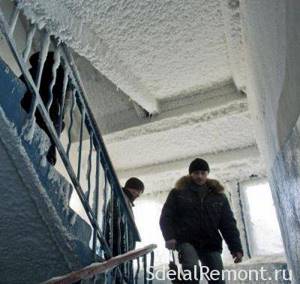
Maintaining the entrance in this condition is a gross violation on the part of the Criminal Code
Consumers, like service providers, have certain responsibilities to preserve the energy resources they receive and maintain the necessary tightness of the premises. Resolution of the Government of the Russian Federation No. 307 establishes such rights and obligations, defines methods for monitoring the quality of services provided, and provides a procedure for recalculating the amount of payment in case of violation of consumer rights. Where to complain about poor heating and how to file a complaint.
Air ratio parameters
The room must have a certain air exchange rate, for example, if the room is residential and has an area of 18 or 20 m 2, then the rate should be 3 m 3 / h per square meter. m., the same parameters are also necessary in regions where the temperature reaches −31°C and drops below.
In dormitory kitchens and apartments equipped with electric and gas two-burner stoves and having an area of up to 18 m 2, aeration is 60 m 3 / h.
If there is a three-burner appliance in the room, then this value will be 75 m 3 / h, if there is a gas stove with four burners - 90 m 3 / h.
For a bathroom with an area of 25 m2, the air exchange rate should be 25 m3/h, and for an individual restroom with an area of 18 m2 - 25 m3/h. If the bathtub and toilet are combined and their area is 25 m 2, then the aeration is 50 m 3 / h.
If the common restroom has an area of 16 m2, then an air exchange rate of up to 50 m3 / h is required for one toilet, and 25 m3 / h for a urinal.
If the room is corner, then the room should be 2°C higher than usual.
During warm periods, the temperature in the elevator room should not exceed 40°C.
Temperature measuring instruments
» » Various instruments are widely used to measure the temperature of water at the inlet and outlet of a hot water boiler, feed water, and superheated steam.
These devices are divided into thermometers for measuring temperature using the contact method and pyrometers for measuring temperature using the non-contact method. According to the principle of operation, expansion thermometers are distinguished (liquid, manometric and dilatometric), thermoelectric thermometers, resistance thermometers. Expansion thermometers are used, the principle of operation of which is based on the property of bodies under the influence of temperatures to change their volume and, therefore, geometric dimensions. Liquid glass thermometers are indicating devices installed at the measurement location.
The working substances used are mercury and some organic substances: toluene, ethyl alcohol, kerosene. A glass liquid thermometer consists of a reservoir 5 and a glass capillary 4. The capillary is located along a scale 3, on which temperature marks are marked in degrees Celsius. The upper end of the capillary is closed.
The upper end of the capillary is closed. Behind the upper mark of the scale, a reserve volume 1 is left in the capillary, filled with inert gas, which protects the device from damage due to overheating.
All parts of the thermometer are enclosed in a glass protective shell 2. Liquid thermometers have the following measurement limits: mercury from -35 to +650°C, toluene from -90 to +200°C, kerosene from -60 to +300°C, alcohol from - 80 to +70°C. To measure the temperature of the medium in pipelines, boilers, and vessels under pressure, thermometers are installed in protective sleeves. To ensure good thermal contact, the sleeve is filled with mineral oil. Solids, like liquids, change their geometric dimensions depending on temperature.
The operating principle of dilatometric thermometers is based on the thermal expansion of bodies. Dilatometric thermometers are not indicating instruments, but are used, as a rule, in alarm and protection circuits. Devices of this type include temperature relays (TR-200) and dilatometric electric temperature control devices (TUDE). Manometric thermometers consist of a cylinder placed at the temperature measurement site, a connecting tube (capillary) and a spring pressure gauge.
The cylinder contains gas or low-boiling liquid, the pressure of which is transmitted to the tubular spring of the pressure gauge. The pressure gauge scale is graduated in degrees Celsius. The figure below shows the device of a pressure gauge thermometer. A metal thermocylinder 1 is connected via a capillary 2 to a tubular spring of a pressure gauge, the arrow of which shows the measured temperature.
Depending on the substance with which the thermoball is filled, manometric thermometers are gas, condensation and liquid. The action of an electric resistance thermometer is based on the property of metals to change their electrical resistance when the temperature changes. The sensitive resistance element is made in the form of a spiral made of wire wound on a frame 5 of insulating material.
We recommend reading: Is it necessary to make photocopies of documents at the traffic police to register a car?
The sensitive element is enclosed in a protective shell 7, which is sealed with a ceramic sleeve 3. The protective cover 4 has a threaded fitting with which the thermometer is installed on a pipeline or vessel. Using connecting wires passing through fitting 10, the thermometer is connected to a secondary device that measures the current value.
For this purpose, ratiometers or automatic balanced measuring bridges are used. The figure below shows a general view of the ratiometer. In boiler installations, copper resistance thermometers (TCMs) are most widely used. Resistance thermometers can measure temperatures from -50 to +600°C. The principle of operation of thermoelectric thermometers (thermocouples) is based on the fact that in a closed circuit consisting of two conductors (for example, chromel and copel or iron and copel, etc.)
d.), thermoelectromotive force (EMF) occurs if their hot 5 and cold 6 junctions have different temperatures. A change in the temperature of the working junction will cause a corresponding change in the EMF perceived by a secondary electrical device, which can be a millivoltmeter.
The value of the EMF depends on the material of the wires and the temperature of the hot and cold junctions. Thermoelectric thermometers are designated by the first letters of the electrodes, for example THC - chromel-copel thermometer.
To eliminate errors in the instrument readings, compensation wires are connected to the free ends, which are led to an area with a constant and known temperature.
Compensation wires are made of the same materials as thermocouples, or create the same emf. The electrodes are usually protected with porcelain and steel covers.
In the thermocouple head, the electrodes are connected to compensation wires.
In appearance, thermocouples and resistance thermometers are similar. Using thermocouples, temperatures are measured in the range from -50 to + 1300°C. Pyrometers are used mainly for setting up and testing boilers and are not discussed in this manual.
Did you like the article? Share with friends: Coal is a mineral that is difficult to process.
Coal beneficiation products are Nowadays, the use of suspended insulation materials in the operation of heating networks is relegated to a second place. A system known as mechanical pipe joining can provide the contractor with increased safety, productivity and benefits. Manufacturing processes often require the creation of a vacuum. To obtain a vacuum in chambers of various volumes, the main operating mode of thermal power plants (NPPs) is the normal operation mode, in which the control of the main units. We will consider the main protective actions for feedwater deaerators using the example of a deaerator for a power unit with
- Electrical laboratory up to 1000V - troubleshooting and troubleshooting With the development of technology.
- When choosing a power plant, a person can choose any one.
- Having examined the device and studied some of the properties of vacuum two-electrode lamps (kenotrons), .
- Although solid fuel heating devices are much more economical than boilers running on .
What is the temperature in the batteries?
There are certain parameters on this issue:
- Hot water should be supplied to the taps all year round, the temperature of which should be from +50°C to +70°C;
- During the heating season, heating devices are completely filled with this liquid.
Let's look at how to measure the temperature of a radiator; to do this, open the tap and place a container with a thermometer. In this case, deviations are only possible upward by +4°C.
If a problem arises in this matter, then you need to file a complaint with the Housing Office, but if the batteries are airy, then the application must be written to the DEZ. A specialist will come within a week and fix everything.
Several more methods for measuring the temperature of radiators:
- A thermometer measures the temperature of heating pipes or the surface of a radiator. Add 1 - 2°C to the resulting value;
- In order to make these measurements extremely accurately, purchase an infrared thermometer-pyrometer, which determines the temperature with an accuracy of 0.5 ° C;
- Take an alcohol thermometer and apply it to the selected location on the radiator, glue it with tape and wrap it with any heat-insulating material (foam rubber, flywheel). This is a permanent device for measuring the temperature of the heating system;
- If you have an electrical measuring device at home with the “measure temperature” function, then a wire with a thermocouple is wound to the battery and the temperature of the coolant is measured.
It is important! If the temperature of the heating radiators does not satisfy you, then a commission will come to you based on a complaint, which must measure the temperature of the circulating fluid in the heating system. Their actions must comply with paragraph 4, which is specified in the “Control Methods” of GOST 30494−96, and the measuring device must be registered, state tested and have a quality certificate. Its range should vary from +5 to +40°C, and an error of 0.1°C is also acceptable.
Fast and accurate pipe temperature measurement. Special Russian IR thermometer
With the onset of cold weather, the problem of a comfortable microclimate in the house, which, most often, directly depends on the temperature of the heating pipes, becomes acute again. In order to determine whether the temperature of the pipes in winter corresponds to the required standard values, it is necessary not only to know these values, but also to know how to accurately and easily measure the temperature of the pipes. The choice of a device for measuring pipe temperature and the measurement technique have a large number of nuances, which we will consider in our article.
Russian regulatory documents regulate in detail what the internal air temperature should be in winter. So GOST 30494-2011 Residential and public buildings. Indoor microclimate parameters set the following internal air temperature values in various rooms:
| Period of the year | The name of a room | Air temperature, °C | |
| optimal | acceptable | ||
| Cold | Living room | 20-22 | 18-24 (20-24) |
| Living room in areas with the coldest five-day temperature (probability 0.92) minus 31°C and below | 21-23 | 20-24 (22-24) | |
| Kitchen | 19-21 | 18-26 | |
| Toilet | 19-21 | 18-26 | |
| Bathroom, combined toilet | 24-26 | 18-26 | |
| Facilities for recreation and study sessions | 20-22 | 18-24 | |
| Inter-apartment corridor | 18-20 | 16-22 | |
| Lobby, staircase | 16-18 | 14-20 | |
| Storerooms | 16-18 | 12-22 | |
| Note. The values in parentheses refer to homes for the elderly and disabled. | |||
But this concerns the internal air temperature in the room. It is easy to measure and control, for example, using the RELSIB WT52 Bluetooth thermometer.
If the air temperature does not correspond to the norm, then there are two options. Either the pipes are too cold and the temperature of the coolant in them is too low, or there is too much heat loss and all the heat simply leaves the premises. Let's look at the pipes.
What should be the minimum temperature of heating pipes?
Temperature graphs are designed to control the minimum surface temperature of heating pipes. Temperature graphs show the dependence of the required water temperature in the heating system on the actual outside air temperature. The mandatory compilation of temperature schedules is established by Federal Law No. 190-FZ of July 27, 2010 “On Heat Supply”.
Appendix 1 presents the Temperature graph for heating a residential building after a heating point. In order to determine the required minimum temperature of the pipes in your apartment you need to:
— determine the estimated outdoor air temperature for your city in accordance with the table in Appendix 2;
— determine the type of heating system you have;
— at the intersection of the outside air temperature and the corresponding measurement point in the table of Appendix 1 there will be the required minimum temperature of the heating system at the moment.
To control the water temperature in the heating system, it is necessary to take measurements on the pipes: supply and return. Pay special attention, not on heating radiators, but on pipes, since regulatory documents regulate these control points and only measurements at them will have legal significance.
How to measure the temperature of heating pipes?
The issue of choosing a measuring tool is extremely important, since the accuracy of your measurements entirely depends on it. You cannot measure temperature with a regular mercury thermometer. It is designed for temperatures up to 42 degrees and will simply burst, since the temperature of the pipes is almost always higher.
The main feature of pipes that affects the measurement accuracy is their round shape. On round surfaces it is very difficult to ensure high-quality contact of the thermometer with the surface being measured and to exclude the influence of the air temperature at the measurement site on the sensor of the measuring device. That is why advice appears on the Internet when measuring the temperature of pipes with an alcohol thermometer, wrap it tightly to the pipe and cover it with heat-insulating material. Not to mention the fact that such manipulations are extremely labor-intensive, they in no way guarantee the accuracy of the measurement.
The most correct, modern and accurate way to measure the temperature of pipes is to use an infrared thermometer (pyrometer). But a conventional pyrometer is not without its drawbacks and does not guarantee accuracy when measuring pipe temperatures.
When measuring temperature with a contact thermometer, you measure the temperature of a point on a surface. A pyrometer always takes the temperature not from a point on the surface, but from a spot of a certain area. The further the meter is from the measurement surface, the larger the temperature measurement spot. Moreover, the cheaper the pyrometer, the larger the spot. In addition, inexpensive pyrometers do not have an indication of the boundaries of the spot on the measured surface. In other words, such pyrometers take the temperature from a large spot on the surface, but you do not see the boundaries of this spot. You only see the laser pointer dot. Almost everyone who uses a pyrometer is misled by this point. People think that the temperature is taken exactly from this point, but in fact this point is nothing more than a convention. On average, at a distance of 1.2 meters, the measurement spot of a standard pyrometer will be 10 cm in diameter. In other words, at this distance the pyrometer will show a certain resulting temperature of the pipe, plus everything that is around the pipe, but here we can’t talk about any accuracy. Therefore, the pyrometer must be located as close as possible to the measurement object, which is often impossible to do at high altitudes or in hard-to-reach places when bending pipes.
Measuring the pipe temperature with a RELSIB IT-7-IR pyrometer and a conventional pyrometer with an interval of 1 minute.
|
|
| Pyrometer RELSIB IT-7-IR | Conventional pyrometer (distance to pipe 40 cm) |
When measuring the temperature of pipes in a dusty or humid room, the measurement accuracy also decreases in proportion to the degree of pollution or air humidity.
All these problems are eliminated when measuring pipe temperatures with a RELSIB IT-7-IR pyrometer.
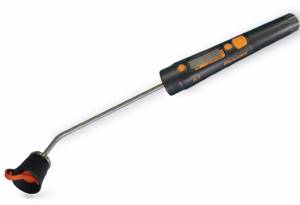
To measure the pipe surface temperature using the IT-7-IR pyrometer, they need to touch the surface being measured. This results in a constant minimum measuring distance, which ensures maximum accuracy. At the end of the device there is a rubber hood (ring) that tightly covers the surface of the pipes, preventing extraneous light, dust and moisture from entering the sensor. In this case, only the temperature of the desired surface is measured, i.e. pipes, and not the temperature of the excess spot, as when measured with a conventional pyrometer. To measure the temperature of pipes at high altitudes or in hard-to-reach places, a modification of the IT-7-IR pyrometer with an external probe is available.
The use of a pyrometer with a rubber hood IT-7-IR guarantees high measurement accuracy. This is confirmed by the high repeatability of measurement results at the same place. With a conventional pyrometer, the spread between readings will be several degrees in both directions, so even with multiple measurements they will not be able to accurately measure the temperature.
|
|
|
| Dimension 1 | Dimension 2 | Dimension 3 |
The interval between measurements is 15 seconds.
Please pay special attention that, using the RELSIB IT-7-IR pyrometer, any person will be able to perform the measurement correctly and receive an accurate value of the pipe temperature, but when measuring with a conventional pyrometer, it is necessary not only to know how to measure, but also to have a certain skill.
The IT-7-IR pyrometer is not only very fast (measuring time is 0.5 seconds), but also has no shortage of contact meters. As is known, the sensor of a contact meter has its own temperature and cools the surface at the point of contact, which is why, for measurement accuracy, you have to wait until the surface cooled by the sensor and the sensor itself warm up. When making non-contact measurements using the IT-7-IR pyrometer, there is no need to wait this time.
The RELSIB IT-7-IR pyrometer has high measurement accuracy (±1.0°C) due to the presence of a rubber hood and a high-quality infrared sensor from the Belgian company Melexis.
At the same time, the temperature measurement range of the IT-7-IR pyrometer is from -40 to +200°C, which covers any water temperature in heating pipes; The temperature of the coolant, even at the exit point from the thermal power plant, does not exceed 150°C.
The IT-7-IR pyrometer is also one of the most convenient infrared thermometers on the market. It has a bright LED indicator, which allows it to be used in dark rooms (basements, boiler rooms, etc.). The operating temperature range from -40°C allows you to take measurements outdoors without loss of accuracy. The sensor's protective cover keeps it clean during storage and transportation.
Appendix 1. Temperature graph of the heating system of a residential building after the heating point.
Appendix 2. Estimated outdoor air temperatures during the cold period in a number of Russian cities.
see also
| Infrared temperature meter IT-7-IR (pyrometer) |
Alexander Glukhov
December 13, 2019
Regulations in force in Russia
Let's look at some parameters that depend on the outdoor temperature.
According to GosStroy Decree No. 170 dated September 27, 2003, if the coolant is supplied to the heating device from bottom to top, then the following standards are adopted, which are shown in the table:
| Outdoor air temperature (°C) | Return (in °C) | Supply pipe (in °C) |
| +5 | 39 | 50 |
| +4 | 41 | 53 |
| +3 | 43 | 56 |
| +2 | 45 | 59 |
| +1 | 46 | 62 |
| 48 | 65 | |
| −1 | 50 | 67 |
| −2 | 51 | 70 |
| −3 | 53 | 73 |
| −4 | 54 | 76 |
| −5 | 56 | 78 |
It should also be taken into account that the temperature of the circulating fluid at the entrance of the heating system to the room must correspond to the schedule that regulates the utility network for a particular room.
According to SNiP - 41−01−2003 “Heating, ventilation and air conditioning”, which specifies standards not only for administrative, public, but also for residential buildings, it is emphasized that:
If the heating system is two-pipe, then the maximum coolant temperature should be +95°C, and if it is single-pipe, then +105°C.
What does temperature depend on?
There are several other factors that influence indoor temperature:
- If the air temperature outside is low, it will be lower indoors;
- Wind speed also has an impact on temperature. The stronger the wind loads, the greater the heat loss will be through windows and entrance doors;
- Tightness of sealing joints in the walls of the house. For example, metal-plastic windows and insulation of facade walls can significantly affect the temperature inside the home.
Everything described above is undoubtedly important. But the main factor that greatly influences the temperature in the rooms is the temperature of the heating radiators themselves. Typically, heating batteries powered from a central system have a temperature of 70 - 90°C.
It is known that the required temperature inside the room cannot be achieved by this factor alone, taking into account the fact that different rooms should have different temperature conditions due to their different purposes.
The temperature inside the room is also influenced by how intense the movement of people inside it is. Temperatures will be higher where people move the least.
This is the basis of heat distribution. As evidence, in sports facilities where people are constantly moving, the temperature is maintained at 18°C, since maintaining a higher temperature is not advisable.
Factors influencing the temperature of radiators:
- Outside temperature;
- Type of heating system. Standard for a one-pipe system: +105 °C, for a two-pipe system: +95 °C. The difference between supply and return should not be more than 105 - 70 °C and 95-70 °C, respectively;
- Directions for the flow of coolant into the batteries. In the case where the wiring is from above, the difference will be: + 20 °C, from below - +30 °C;
- Type of heating device. Radiators and convectors differ in heat transfer, which means that the temperature regime is also different. Convectors have lower heat transfer than radiators.
It is naturally clear to everyone that, regardless of whether it is a convector or a radiator, heat transfer will directly depend on the temperature outside. At zero street temperature, the heat transfer rate of radiators should vary within 40-45 °C supply and 30-35 °C return. For convectors, these characteristics are as follows: 41-49 °C supply and 36-40 °C return.
When the thermometer drops to -20 °C, these characteristics will be as follows: for radiators - supply 67-77 °C, return 53-55 °C, for convectors - supply 68-79 °C and return 55-57 °C. But when the thermometer reaches -40 °C, both radiators and convectors will have the same characteristics: supply 95-105 °C, return temperature 70 °C.
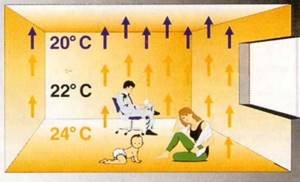
conclusions
The legislator established standards for the characteristics of the heating system, paying special attention to the optimal temperature in the living room. Its value is the most important for residents, and it is also easy to check. If it is lower than required, it means the battery is not heated enough. And in case of non-compliance with the standards, you can file a complaint with the service organizations, not forgetting about recalculating the fee if it is discovered that heating services are of inadequate quality.
Lawyer. Member of the Bar Association of St. Petersburg. More than 10 years of experience. Graduated from St. Petersburg State University. I specialize in civil, family, housing, and land law.
Source
